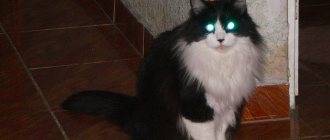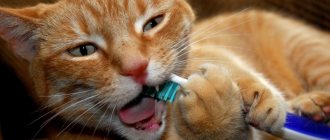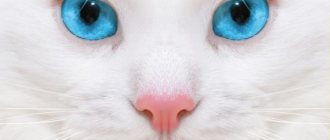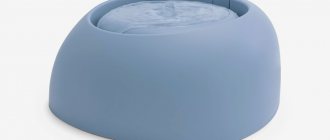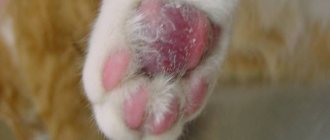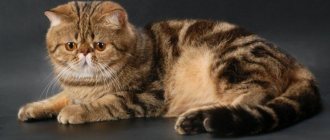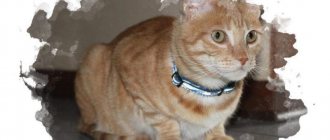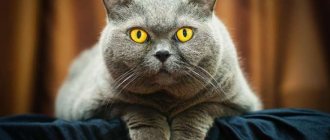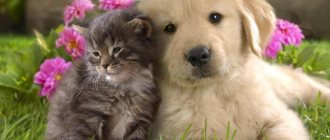Pet owners have endless questions about what cats can and cannot eat. One such question is: can cats drink tea? The answer is yes , but you should always exercise moderation to prevent any possible side effects. A small amount per day won't hurt. Make sure your cat's main source of hydration remains filtered water.
Does your cat always try to drink tea when you leave the cup on the side? Cats will often try to lick, sniff, and even drink tea, but this can be dangerous for cats, especially if the tea contains caffeine.
Cats and tea: what you need to know
From green tea to oolong to sweet tea, there's a tea to suit every taste. Recently, tea made from finely ground powder of specially grown and processed green tea leaves has become increasingly popular.
© shutterstock
Tea leaves contain a variety of chemical compounds, including stimulants such as caffeine, theobromine and theophylline, xanthines, and antioxidants called polyphenols. People often drink tea simply for its refreshing effects, and several chemicals contained in tea have been shown to have beneficial effects on people. Although humans also drink this substance to help their voice or throat, kittens usually do not need to drink it for this purpose. But what about cats?
Results
It may not be a big deal if your pet jumped on the table and accidentally tasted the tea from your cup. However, it is better to observe it for several hours. If you notice hyperactivity or other unusual changes in your cat's behavior, we recommend contacting your veterinarian.
Tea, even green tea, contains a large amount of caffeine and is therefore harmful to your cat's health. However, a furry friend can keep company during tea time if he is offered herbal drinks without milk or sugar. Herbal teas will provide your pet with vitamins, minerals and antioxidants that help fight infections and promote faster wound healing. These drinks also have a calming effect.
Based on materials from excitedcats.com
Can cats be given tea?
Some cats like to drink tea from time to time. Drinking in small quantities is likely not a problem. But drinking large amounts of tea can lead to serious health problems for your cat due to the chemical compounds contained in the tea.
For example, caffeine consumption can cause cats to become hyperactive, restless, vomiting, increased heart rate, increased blood pressure, irregular heartbeat, tremors, and elevated body temperature. In severe cases, convulsions and collapse may occur. In rare cases, the result can even be death.
Another substance found in tea is theobromine, better known as the chemical in chocolate that causes toxicity in dogs. Since cats don't have sweet taste buds, you don't often hear about chocolate poisoning in cats. However, cats also suffer from this condition and may be even more sensitive to theobromine than dogs.
Theobromine can affect a cat's body in several ways, including:
- Increases heart rate
- Lower blood pressure
- It is a diuretic and may increase fluid loss.
- Stimulates their nervous system
- Relaxes smooth muscles
While most cats won't be harmed by a small amount of tea, why risk your beloved pet's health by giving him something that contains chemicals that are considered poisonous? If your cat asks for tea, simply say “NO!”
How to care for the eyes of dogs and cats
#advice-from-the-vet-point
The living conditions for our four-legged pets, unfortunately, are moving further and further away from what is “naturally appropriate.”
Low humidity in city apartments, an abundance of house dust in dry apartment air, city dust mixed with concrete dust, residues of fuels and lubricants and de-icing agents - all this does not have the best effect on the condition of the eyes of our pets.
Therefore, even the eyes of our four-legged city dwellers, healthy from allergies and infections, often need additional care.
Do your pet's eyes need our help?
Some naturally healthy and adaptable animals do not require eye care throughout their lives. Others cannot last even a day without the help of their owner.
This can only be determined in relation to the conditions in which your dog or cat is currently kept. When moving to another place of residence, the condition of the eyes (if it is not an infection) can change significantly without human intervention.
Signs of eye problems are often visible to the naked eye. The main thing is to pay attention to them in time:
- Dry crusts quickly accumulate in the inner corner of the eye and have to be removed by rinsing or simply using your finger.
- The eyelids are swollen and “stuck together.”
- Excessive tear production is observed, and moist “tracks” form under the eyes.
- The discharge from the eyes is thick, it dries on the eyelashes or is visible on the surface of the cornea in the form of translucent clots.
If you notice any of the above in your pet, then he cannot do without your help.
Please note that all further recommendations are given for animals that have normal body temperature, are active, have a good appetite and normal level of thirst, preserved stool and urination, and in general - for those that are clinically healthy .
If your pet’s condition gives you any concern, contact your veterinarian immediately, because discharge from the eyes can be only one of the symptoms of an infectious or other serious disease.
Discharge from the eyes can be a sign of a serious illness!
What is used to treat the eyes of dogs and cats?
The simplest thing you can use is saline solution (sodium chloride 0.9%). It can be used to wash the eyes in unlimited quantities and as often as necessary. It should also be used when you suspect an eye injury in your pet. In this case, other means can be downright dangerous!
If you suspect an eye injury, wash off the crusts and rinse the eye with sterile saline or, as a last resort, boiled water. It is dangerous to use other remedies without consulting a doctor!
In addition, to care for your pet's eyes, you can use special lotions or drops designed specifically for eye care. These are lotions already familiar to us, “Vetoquinol” or “Global-Vet”, as well as the “Phytoelita” series (Veda LLC) and “Diamond Eyes” drops (“Agrovetzaschita” - “AVZ”). Be careful, sometimes pets may have an allergic reaction to a specific lotion. In this case, the use of such lotion should be stopped immediately.
Read labels carefully and use products exactly as directed.
I will also voice a finding from the owners of my patients, confirmed by years of successful observations: you can take care of your pet’s eyes using contact lens fluid. The composition of these liquids provides effective disinfection, mechanical rinsing of irritants, moisturizing and protecting the cornea and conjunctiva of our pets' eyes.
Herbal infusions and teas, can they be used to wash the eyes?
Separately, I would like to say about infusions of medicinal herbs for washing the eyes of pets: chamomile, sage, calendula, green tea, etc. Such infusions are very useful, however, there are two important points: the possibility of an individual allergic reaction to infusions and the need to carefully filter or settle the infusion before use, so as not to injure your eyes with the remains of herbs.
To preserve the benefits of infusions and not spend a lot of time on preparation. You can make an herbal infusion and freeze it into cubes. As necessary, infusion cubes can be thawed (for example, by diluting with a small amount of boiling water - in this case, the frozen infusion should be more concentrated than necessary for consumption) and used to wash the pet's eyes.
Separately, there are questions about whether it is possible to wash the eyes of dogs and cats with tea?
And, if possible, then what kind, fresh or “sleeping”, standing? And is it possible to use tea “in bags” for this?
Tea is a herbal infusion like the others. Fresh green and black tea have an irritant and antimicrobial effect. Standing tea contains tannin, a tanning and disinfectant substance. It is not recommended to rinse your eyes with fresh tea due to its irritating effect.
“Sleeping” standing tea can be used once or twice (before purchasing a more suitable product) to wash the eyelids of a dog or cat in “field conditions” when they are inflamed. Why should tea be “sleepy”? So that the concentration of tannin in it is not higher than desirable.
Like any other herbal infusion, tea must be filtered. The easiest way is to wrap wet “sleeping” tea leaves in several layers of clean cloth or sterile gauze (bandage) and rinse your pet’s eyelids, removing crusts of discharge from them. Try not to get any excess tea deep into your eyes.
Can tea bags be used? This is highly undesirable due to its poor quality and the abundance of “tea dust” that can get into the eye even after filtration.
Do not use tea bags to wash your eyes - it is dangerous!
How to wash eyes for dogs and cats
It is advisable to wash your pet’s eyes from 1 time a day (at night) to 3 times a day (for example, after each walk), generously moistening a cotton pad with the liquid of your choice and moving it along the eyelid towards the inner corner of the eye. Possible directions are from the outer corner of the eye to the inner, around the eyes, from the center to the periphery.
Only those products that are intended for this purpose can be injected directly into the eyes!
Read the label carefully and remember that “for washing the eyes” and “for caring for the hair around the eyes” are not the same thing!
When washing your eyes, try to use solutions and lotions at room temperature, or better yet, at body temperature. Cold solutions can cause discomfort in your pet and problems with his eyes in the future.
Do not use cold eye washes!
Strictly observe the expiration dates of lotions and solutions - there is no need for extra germs in your eyes!
If washing within 3-5 days does not cause a significant improvement in the condition of the eyes and a reduction in discharge, be sure to consult a veterinarian .
If the advice of a general practitioner does not help within a week, do not wait for “sea weather” and contact a veterinary ophthalmologist !
Healthy and shining eyes to your pets!
Natalya Troshina, veterinarian (DVM)
Is green tea toxic to cats?
Green tea is generally safe for cats in small quantities. To give you an idea, it takes five cups for your cat to experience poisoning. Even I won't drink that much tea in a day.
Warm tea is a calming drink for your cat during the winter. However, there is one substance to watch out for: caffeine. Each cup of tea contains 70 mg of caffeine. This amount is not enough to poison a cat. It would take about 40 mg of caffeine per kilogram to cause serious illness in pets.
Of course, tea doesn't have as much caffeine as coffee. However, caffeine is not ideal for cats. Small amounts of caffeine may not cause adverse reactions, but it's not worth the risk.
© shutterstock
Green tea contains high levels of catechins, polyphenols that act as antioxidants. It is known to slow cell damage, among other health problems. Research also shows that polyphenols have the ability to provide additional protection against UVB rays.
You can also apply green tea topically to heal infections on your cat's fur. Please note that only green tea provides these benefits. Other types of tea may affect your cat differently, so you should always consult your veterinarian.
Why does a cat like tea?
Some cats are tea drinkers for a variety of reasons. Others say that because it is herbal, the tea's scent can be reminiscent of catnip. You should know that cats have different tastes. One cat may like tea, but another may not.
However, no matter how much your cat begs for tea, you should not give it too much. Again, most teas contain caffeine, which is not good for your kitty. In addition, tea contains oxalic acid, which can cause kidney problems if taken in large quantities.
Surprisingly, some cats don't like the smell of the bags. A strong smell can scare away a curious kitten.
What to feed your pets?
Any recommendations from veterinarians in case of heat start with one thing: the animal may not eat, but it must drink. What exactly should I give him, in what quantity, at what time, and is it possible to give him something else besides water?
Bottle or tap?
The main drink for cats and dogs is the same as for their owners: ordinary clean water. It is advisable to use bottled drinking water, but you can also give regular tap water, passed through a household filter. It is good to give spring and well water to drink, but after warming it up, ice water should not be given to animals, so as not to solve the problem of sore throat later. The animal will decide how much to drink; your task is to ensure an uninterrupted water supply.
For example, it is not enough to pour your dog a bowl of water (about 1.5 liters) and leave for work all day - on a hot day, she may need two such servings.
At home or on a walk?
What is harmful to humans will not benefit animals either. Therefore, no attempts to drink from a puddle. You cannot give dogs and cats water from a lake, pond or river. If you take them outdoors, think about what they will drink. In a real, non-suburban polluted forest, you can give people to drink from streams or springs, in other cases - only the water that you drink yourself. You can drink from a special traveling bowl made of waterproof fabric - when folded, it will even fit in your pocket.
Plastic or metal?
At home, experts advise pouring water into ceramic bowls. In the case of cats, it is desirable to have a dark color so that the animal can see the surface of the water. Ceramics do not release anything into the water, and in such a bowl the water stays fresh longer.
You can also drink from plastic and metal cups, but cats are not always willing to drink from them due to the taste present in the water, and some dogs experience irritation when they come into contact with wet metal. This applies to breeds with skin folds (body folds) on the neck - basset dogs, sharpeis, pugs, chow chows, mastino dogs and bearded dogs - schnauzers, bearded collies, terriers. Such animals must wipe their faces after drinking so that the wet fur does not rot, irritating the skin.
Drink the tea yourself, share the kefir with the cat
Milk. It's possible, but not necessary. Milk is a baby food; an adult body does not need it. After about 3–5 months, dogs have a decrease in the amount of enzymes that break down milk sugar; an adult dog that drinks milk may experience an acute attack of diarrhea. The same applies to cats, and people too.
Kefir and other fermented milk. But this is, in principle, useful for both humans and dogs. You can give kefir, yogurt, yogurt, bifidok, but not instead of water - this is still food, not drink. It is better to give fermented milk products during evening feeding as an addition to the main meal. And little by little - for a medium-sized dog, for example, 1-1.5 cups of kefir or yogurt will be enough. It’s more difficult with cats: most cats eat ready-made food, and in this case it’s not recommended to give anything other than water.
Black tea. Veterinarians allow black tea only in one case - if the animal has an attack of diarrhea and nothing else is available. It should not be hot and too sweet - slightly sweetened is better. Under normal conditions, neither a dog nor a cat needs tea and can be harmful.
Coffee. Under no circumstances, not even for fun! An animal is not a person; for him, even a tiny dose of caffeine will be shocking and can lead to overexcitation and serious problems with the cardiovascular system.
Herbal tea. Many owners give their animals herbal tea as an anthelmintic - or rather, they try to give it, because the client, as a rule, reacts disapprovingly to the bitter drink. Veterinarians also do not approve of the idea: firstly, parasites cannot be removed in this way anyway, and secondly, herbs are not at all harmless to the animal’s liver and kidneys.
Can animals have mineral water?
Traditionally, having a respectful attitude towards mineral water, people try to introduce animals to it. Is it possible to give dogs mineral water? We asked dog handler Olga Nikitenkova, an expert of the Russian Canine Federation, president of the Velikiye Luki Dog Breeders Club “Cerberus”:
– Mineral water can be given, but on condition that all gases have been removed from it. Usually they do this: buy a salty mineral water, open it, let it sit overnight and pour it into the dog’s bowl in the morning. This water allows you to replenish the salt balance in the body in hot weather. But not all dogs agree to drink mineral water; they need to be taught this from puppyhood. It is not worth giving this kind of water all the time, and there is no need for it - regular drinking water is enough for the dog. It should be fresh and cool - such water is saturated with oxygen and quenches thirst well, but the dog may refuse to drink warm water that has stood at room temperature for a long time. It is better to change the water in the bowl more often, at least twice a day. If a dog lives in a city apartment and is left alone for a long time, it is good to have a special semi- or automatic drinking bowl - then the animal will not have problems with access to fresh water.
If you don’t have regular water at hand, you can give mineral water to your cat, but, according to Yulia Didenko, a therapist at the Bely Klyk veterinary clinic, it is not advisable to constantly feed your animal with it:
– Mineral water will not lead to urolithiasis overnight – salts are deposited for more than one day, and besides, the animal must have a predisposition to this: most often stones are formed due to inflammation of the urinary tract. Mineral water with gas should definitely not be given to cats! Without gas - only if there is no table water, that is, as a last resort.
